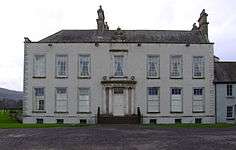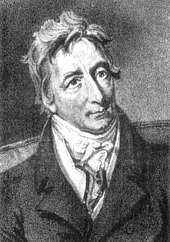Thomas Marlay
Thomas Marlay (c.1680–1756) was an Irish politician and judge, who ended his career as Lord Chief Justice of Ireland. He is remembered chiefly for the rebuilding of Celbridge Abbey, and as the grandfather of the statesman Henry Grattan.
Background
He was born at Creevagh Beg, near Ballymahon, County Longford. His mother Elizabeth Morgan was the daughter of Robert Morgan of Cottlestown, County Sligo, and his wife Bridget Blayney of Castleblayney, County Monaghan. His father Anthony Marlay was a recent arrival in Ireland from Newcastle-upon-Tyne, where Thomas's grandfather Sir John Marlay (1590-1673) had been a leading local politician, who served as both Mayor of Newcastle and its MP; he is chiefly remembered for his spirited defence of the town against the invading Scots army during the English Civil War.[1] Beginning as small tradesmen, the Marlays had risen to become among the wealthiest coal exporters in Newcastle.[2]
George Marlay, Bishop of Dromore 1745-1763, was Thomas's younger brother, and gave his name to Marlay House, which was built by his son-in-law, David La Touche. David was an MP, a member of the Privy Council of Ireland, and first Governor of the Bank of Ireland. He married George's daughter, Elizabeth in 1761.

Early career
Thomas was educated at the University of Dublin, and unlike many barristers of his time he was a considerable scholar, who was awarded the degrees of Bachelor of Arts and Doctor of Laws. He was admitted to the Middle Temple, and was called to the Bar. He rapidly built up a large practice at the Irish Bar, although Elrington Ball states that he was not very highly regarded as a lawyer. An anonymous pamphlet from 1730, which took a somewhat jaundiced view of the Irish Bar in general, described him as "a sage refined": whether this tribute to his intellect was ironic or not is unclear.[3]
He was elected to the Irish House of Commons as member for Limavady in 1715, and as member for Lanesborough, 1727-31. He was appointed Solicitor-General for Ireland in 1720 and Attorney-General for Ireland in 1727. He was elevated to the Bench as Lord Chief Baron in 1730 and became Lord Chief Justice of the King's Bench in Ireland in 1741.
Judge
His most memorable trial as Lord Chief Justice was the so-called Annesley perjury case, Annesley v. Lord Anglesey, in 1745. This was one of several trials arising from the celebrated legal battle between James Annesley and his uncle Richard Annesley, 6th Earl of Anglesey as to which of them was the rightful holder of the Anglesey title and estates; the case is said to have inspired the novel Kidnapped by Robert Louis Stevenson. The trial was notable for lasting twenty-two hours without a single break and Marlay, who would normally have had 2 or 3 colleagues to support him, conducted it singlehanded. The verdict went in favour of James, but he died before his uncle, without having regained possession of his estates.
A workload as heavy as Marlay's was bound to affect his health, and from 1749 onwards he was too unwell to go on assize; he retired on health grounds in 1751. He died in Drogheda in 1756, while on a visit to his colleague Henry Singleton. He was a popular figure and his death seems to have been genuinely mourned: a Dublin paper published verses praising his gentleness, perfect manners and scholarship (the last being rather unusual among Irish judges of the time).[4]
Family
Marlay rebuilt Celbridge Abbey, which is chiefly remembered as the home of Esther Vanhomrigh, the beloved Vanessa of Jonathan Swift.
He married Anne de Laune (died 1769),[5] daughter of Charles de Laune, in 1707, and had ten children, of whom several died young. Their surviving children included Colonel Thomas Marlay; Richard Marlay, Bishop of Clonfert and later Bishop of Waterford; Anthony, who inherited Celbridge Abbey; and Mary,[6] mother of the statesman Henry Grattan.

References
- Wedgwood, C.V The King's War William Collins and Son 1958
- Henning , B.D. editor The History of Parliament: the House of Commons 1660-1690 1983
- A View of the Bar, anonymous pamphlet, 1730
- Ball, F. Elrington The Judges in Ireland 1221-1921 John Murray, London, 1926
- Lodge, John. The Peerage of Ireland, Vol 6, p. 304 London: 1785
- There is a good deal of confusion about her first name, which some sources give as Alice.
| Legal offices | ||
|---|---|---|
| Preceded by John Rogerson |
Solicitor-General for Ireland 1720–1727 |
Succeeded by Robert Jocelyn |
| Preceded by John Rogerson |
Attorney-General for Ireland 1727–1730 |
Succeeded by Robert Jocelyn |
| Preceded by Thomas Dalton |
Chief Baron of the Irish Exchequer 1730–1741 |
Succeeded by John Bowes |
| Preceded by John Rogerson |
Lord Chief Justice of the King's Bench for Ireland 1741–1751 |
Succeeded by St George Caulfeild |